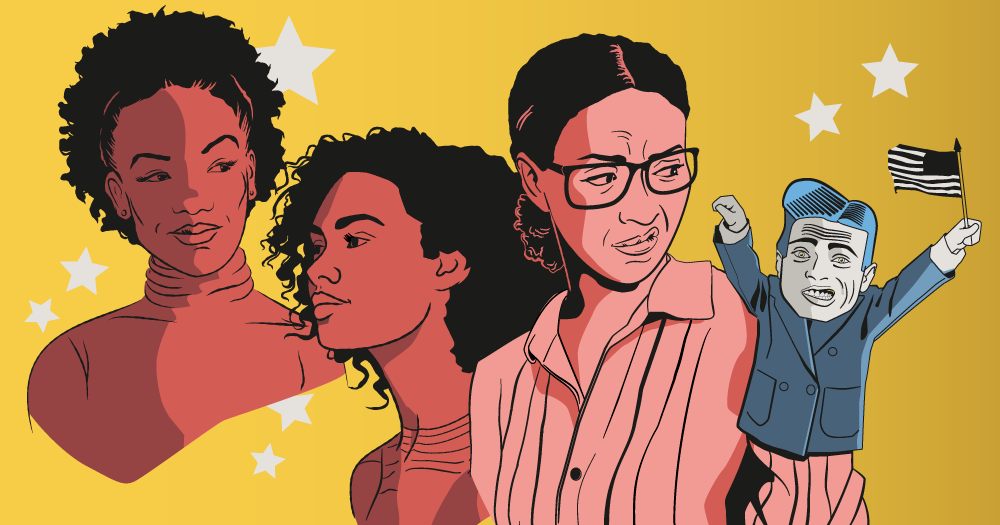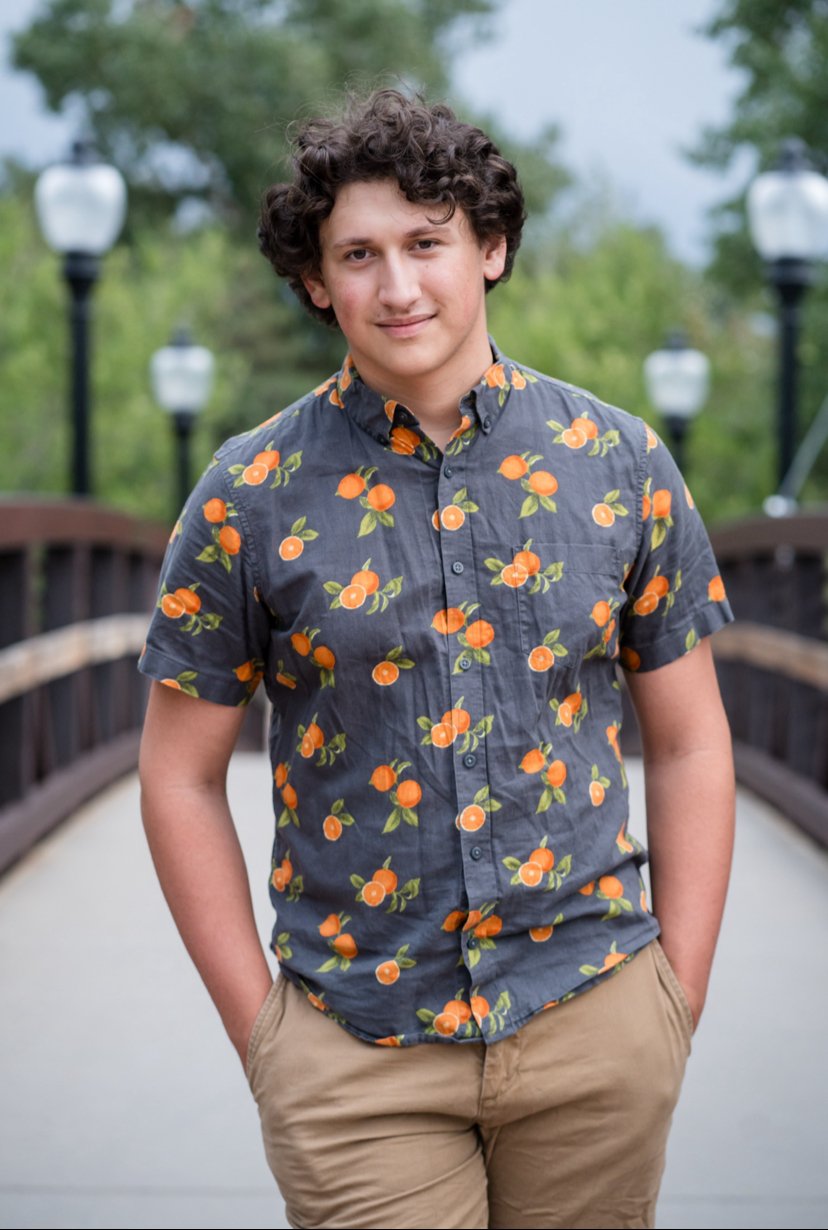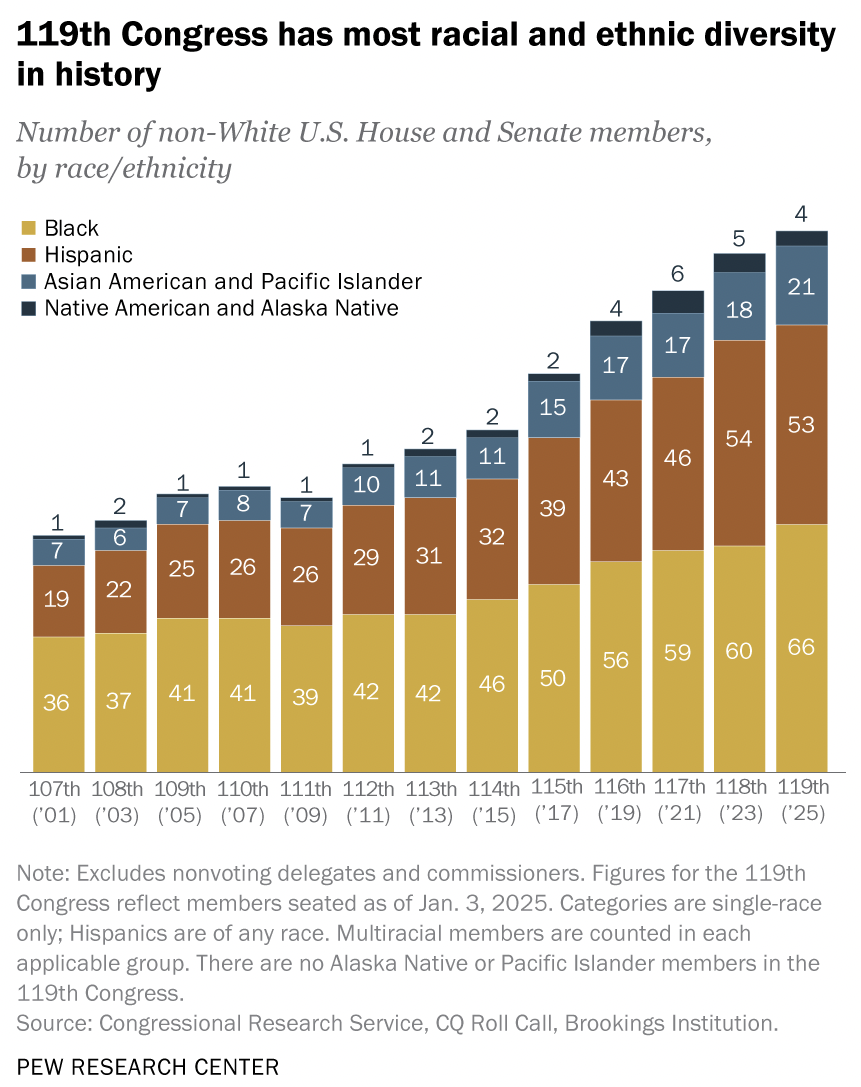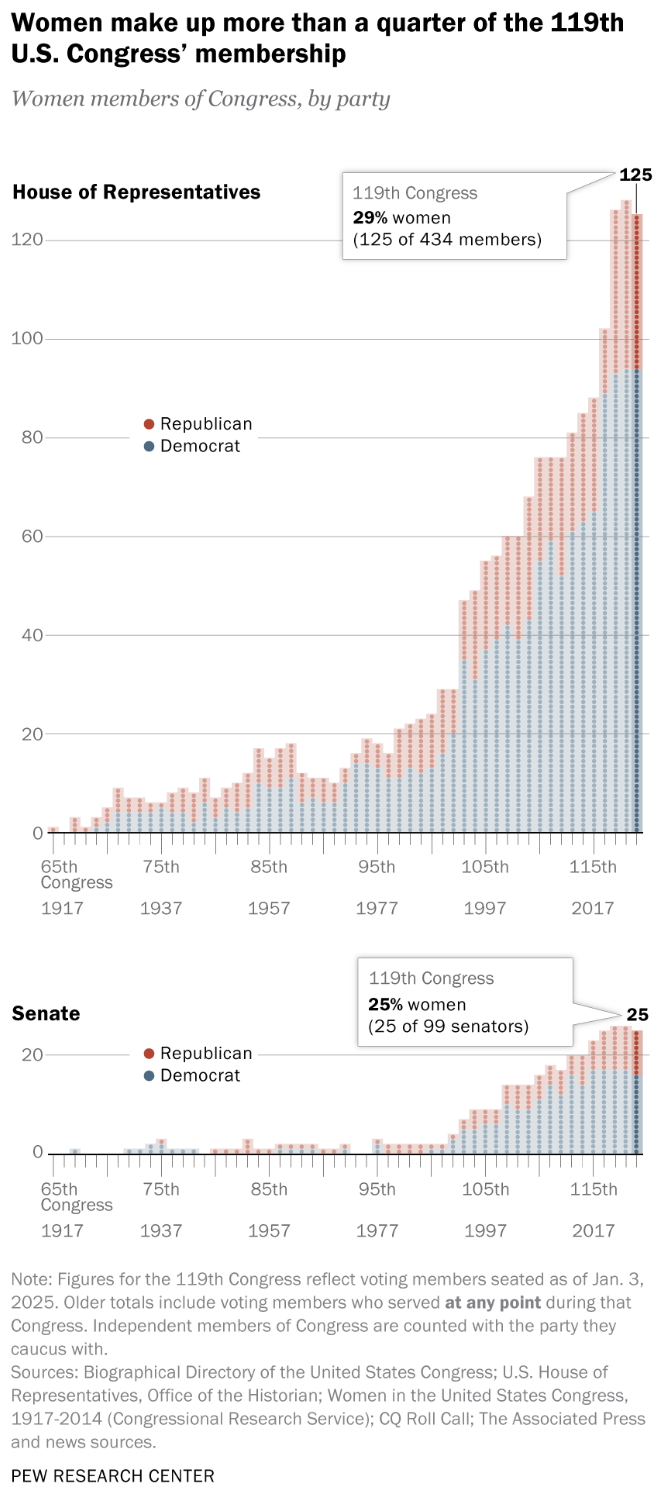POTUS: Or, Behind Every Great Dumbass Are Seven Women Trying to Keep Him Alive
Written By Selina Fillinger | Directed by Alice DaCunha
Harrison Pina
Production Dramaturg
POTUS Dramaturgy Resource!
This living document will serve as a valuable hub of resources exploring the history, culture, and other important information revolving around Selina Fillinger’s POTUS: Or, Behind Every Great Dumbass Are Seven Women Trying to Keep Him Alive.
As this production’s dramaturg, it is my goal to support the cast, crew, and creative team by providing context, information, and answers to any curiosities regarding the play. Feel free to ask any questions or make suggestions as to how I can aid this process either through email (at hpina@luc.edu) or in person at any time!
Selina Fillinger
Writer | Performer | Three-Time Tony Nominee
Selina Fillinger was born into a Jewish family in Berkley, California spent the majority of her childhood in Eugene, Oregon before attending Northwestern University. Studying acting and playwriting at Northwestern led to the start of her professional career, being the first recipient of the Judith Barlow Prize (an award celebrating a student-made, original one-act play inspired by the work of a historic woman playwright) as well as having her work featured, two years in a row, at Northwestern's Agnes Nixon Playwriting Festival (which focuses on the creative development of three new undergraduate plays).
At the end of her senior year, she received commissions to produce her works in Northlight Theatre (Faceless in January 2017) and Sideshow Theatre (Something Clean premiering at the Roundabout Underground in New York in 2019). Following her young success, at just 28 years old, POTUS: Or, Behind Every Great Dumbass Are Seven Women Trying to Keep Him Alive premiered on Broadway (Shubert Theatre; April 2022). The play received three Tony nominees and made her one of the youngest playwrights to have their work produced on a Broadway stage.
About POTUS
Selina Fillinger’s self-described political farce features an entirely female cast occupying differing roles within the White House. The women soon become responsible for managing and finding their way through a hilariously chaotic sequence of events.
After the President makes a brash comment about his wife's attitude, ties and relationships with the United States presidency quickly shift with external complications. Harriet, Jean, and Margaret try to manage the situation as it becomes more disastrous with a barrage of PR nightmares introducing Stephanie, Dusty, Chris, and Bernadette and untimely personal matters involving the President. Tensions rise further and ends with an unconscious and potentially dead President.
The women trying to hold everything together bounce between solutions for dealing with this crisis, attempting to hide the body and even stage a fake suicide. Turns out, the President is not dead and revived right before having to address the public as the ensemble cast ponders their place in future White House matters.
The play overall offers the niche of a feminist farce with hints of political satire illuminating the American political system through a perspective that gives necessary spotlight on the perspective, especially pertaining to that of a woman.
Rooms in The White House
Scene 1.1 - Press Secretary’s Office
Scene 1.4 - Women’s Restroom
Scene 2.1 - Somewhere in the West Wing
Scene 2.4 - The West Wing
Scene 1.2 - Outside the Oval Office
Scene 1.5 - Chief of Staff’s Office
Scene 2.2 - The East Room
Scene 1.3 - Press Secretary’s Office
Scene 1.6 - Somewhere in the West Wing
Scene 2.3 - The Oval Office
The Seven Women Trying to Keep Him Alive
Harriet
His Chief of Staff: Role originated by Julie White; The Witty Servant/Zanni (manipulates decisions and devises plans while offering comedic commentary and alliance with other characters); representations of morality, burnout, labor, femininity/identity, mentorship, and motivation.
Jean
His press secretary: Role originated by Suzy Nakamura; Ingénue (innocent and potentially naive character, frequently a victim or subject to misdirection) and The Obstinate Figure/Vecchio (often tries to stop the lover from reaching their goals often coming from a place of wisdom, wealth, or social reasoning); representations of maturity, invisible labor, undervalued, emotional exhaustion, and leadership.
Stephanie
His secretary: Role originated by Rachel Dratch; The Scholar/Il Dottore (intellectual who can sometimes be pompous, whose knowledge can lead to humorous blunders) and The Buffoon/The Clown (subject of slapstick and physical humor); Representations of occupational motivation, self-doubt, anxiety, and insecurity.
Dusty
His dalliance: Role originated by Julianne Hough; The Lover/Innamorato (Driven by love and romantic desires) and The Buffoon/The Clown (subject of slapstick and physical humor); Representations of stereotype (bimbo), underestimation, resilience, dysfunctional social expectations, and emotional aspects of the play’s main message.
FDR’s long relationship with his wife’s social secretary, Jaqueline Kennedy reportedly telling a journalist who was sleeping with her husband in the White House, the Clinton-Lewinsky Scandal,
Bernadette
His sister: Role originated by Lea DeLaria; The Boastful Character/Il Capitano (cowardly braggart influenced by an inflated sense of self that is often ridiculed or exposed) and The Lover/Innamorato (Driven by love and romantic desires); Representations of felonious family, contrast to the White House’s professionalism, romantic and familial tensions, resistance to structure, honesty, and chaos.
Reference to Billy Carter: Brother to President Jimmy Carter (39th), became known for his boisterous personality and hard-core drinking habits.
Nixon ordered wiretaps on his brother’s phone, Lyndon B. Johnson ordered the Secret Service to keep his brother prisoner to control his drug habits, Bill Clinton’s half-brother’s Secret Service code was “headache.”
Chris
A journalist: Role originated by Lilli Cooper; The Obstinate Figure/Vecchio, The Scholar/Il Dottore, The Witty Servant/Zanni; Representations of resilience, societal tensions, observation and instigation, contradicting ambitions, motherhood, societal structures, transition, and truth.
Margaret
His wife. The First Lady: Role originated by Vanessa Williams; Ingénue, The Witty Servant/Zanni, The Scholar/Il Dottore; Representations of incompetent or performative relationships, confidence, ambition, diplomacy, social influence, structurally forced sidelining while maintaining professionalism, hypocrisy of power, and nuance.
Glossary
(Chronological Order)
-
Official residence and workplace of the U.S. President, home of many managerial offices (military, transportation agency, management office, etc.) and the briefing room, workers appointed by the President.
(the setting)
-
A collection of pus typically caused by a bacterial infection (in this case near the anus or rectum).
(pg 4)
-
Surgical removal of breast tissue commonly performed to treat or prevent breast cancer.
(pg 6)
-
Main jobs include: manages the information going to and coming from the President, provides daily briefings to the President, and manages communication inside the White House.
Secretaries to the President: No current secretary to the president, Drew Rodriguez (2024-2025), Julia Reed (2022-2024), Ashley Williams (2021-2022), Molly Michael (2019-2021).
(pg 8)
-
The permanent stop of menstruation, which can lead to a decline in estrogen, can cause further health risks and symptoms that alter “typical” biological function.
(pg 9)
-
An object typically shaped like a penis that’s used for sexual stimulation.
(pg 11)
-
Shortened term for Huffington Post, which is known for a wide range of news content. Typically liberal leaning.
(pg 13)
-
Forcing an unwanted/unnecessary person or thing upon another.
(pg 14)
-
A connection or mutual understanding of another’s perspective or feelings.
(pg 20)
-
A screen placed behind a speaker to help vocal projection.
A person/group to suggest ideas to measure a response.
(pg 29)
-
Groups of people that are subject to systemic disadvantage/exclusion from social opportunities (often due to race, gender, sexuality, disability, or socioeconomic status).
(pg 27)
-
A type of farming that focuses on improving the health of the ecosystem while maximizing production.
(pg 29)
-
Vulgar slang referring to air being released from a vagina (often occurring after sexual intercourse or pelvic exercise).
(pg 30)
-
A pair of notorious American criminals during the Great Depression (1932-1934) who were killed in a vehicular ambush in 1934 after their spree of robberies and murders. Their legacy is maintained in American fiction and non-fiction.
(pg 32)
-
Main jobs include: contact point for media, communication to the public, monitoring relationships with reporters/journalists.
Press Secretaries: Karoline Leavitt (current), Jen Psaki (2021-2022), Kayleigh McEnany (2020-2021), Sarah Huckabee Sanders (2017-2019)
(pg 38)
-
Suffragist/suffragette, American Quaker, and feminist, largely involved in the securing of the 19th Amendment (granting women’s right to vote). Alive from 1885-1977.
(pg 45)
-
John Wilkes Booth and Lee Harvey Oswald are both known for assassinations of U.S. Presidents. Booth shooting Abraham Lincoln (16th President) and Oswald shooting John F. Kennedy (35th President).
(pg 50)
-
Also known as supply-side economics or Reaganomics, supports tax-cuts and economic benefits to wealthy businesses in hopes of benefitting those in lower income divisions through more investment and job-creation. Made popular by Ronald Reagan (40th President).
(pg 57)
-
Christians who emphasize personal conversion through the authority of the bible and sharing the gospel. Supports the idea of being “born again”.
(pg 69)
-
Encouragement of aggression towards opposing countries in hopes of inspiring war. Often to better business, power (economic, social, or religious), or become a dominate force.
(pg 71)
-
A ballet jump where a dancer jumps from one foot to another while the leg extends outward midair.
(pg 75)
-
A defamation lawsuit consists of false or destructive statements through writing or other permanent forms.
Libel specifically is a form of defamation through picture, writing, or media aiming to expose hatred or injury to another.
(pg 82)
-
Vulgar slang for genitals associated with a woman, often used to describe someone as unpleasant or stupid (British origin).
(pg 1)
-
Main jobs include: hiring and oversight of the White House Staff, structuring policy and system to support presidential visions, helps plan events, acts as an advisor (policy, political strategy, negotiation, interests), and oversees information flow.
Chief of Staff: Susie Wiles (current), Jeff Zients (2023-2025), Ron Klain (2021-2023), Mark Meadows (2020-2021), John Kelly (2017-2019)
(pg 5)
-
A small blister or pimple on the skin that has pus inside.
(pg 6)
-
A steroid hormone produced in the adrenal gland that regulates metabolism, blood pressure, immune response, circadian rhythm, and stress response.
(pg 8)
-
Also known as an eidetic memory, a rare ability to recall memories or experiences with extreme accuracy after only brief exposure.
(pg 9)
-
Co-founder, chairman, and CEO of Apple, and had served as CEO of Pixar Animation Studios. Known for sporting a black turtleneck sweater.
(pg 12)
-
Saudia Arabia and the United States have a complex and long history with cooperation and tension. Interested economically with security and oil/energy ties but large disagreements with human rights and regional policies (Israeli-Palestine conflict and war with Yemen).
(pg 13)
-
A type of story or article that is often made for light entertainment, often lacking deep analysis or controversy.
(pg 14)
-
Practice of extending a nation’s influence through force and cultural dominance. Most dominating countries have a history of imperialism or are still active in it (United States, United Kingdom, France, Germany, Spain, Japan, etc…).
(pg 21)
-
Korean martial art that emphasizes kicking techniques and high-velocity movement.
(pg 25)
-
A large single block structure made of one material. Metaphorically refers to something large and unified.
(pg 27)
-
Derogatory North American slang referring to a prepubescent girl (ages 10-14) who adopts adult or mature (often overly sexual) behaviors.
(pg 30)
-
A chemical element that is often involved in making blue pigments.
(pg 30)
-
Jaqueline Kennedy Onassis was John F. Kennedy’s wife (making her a First Lady) would typically sport 60s fashion pieces like tweed skirts, pillbox hats, oversized sunglasses, chiffon gowns, or designer bags.
Carl Sagan was an American astronomer and planetary scientist (involved in NASA in first explorations of Mars and of the outer solar system) that would typically wear a turtleneck with a sports jacket.
(pg 32)
-
To think deeply, meditate, or reflect.
(pg 40)
-
Geopolitical significance as a “third neighbor” to the U.S. being between Russia and China (can help balance political standings and influence). The United States and Mongolia often have diplomatic relations sharing democratic values and economic interests.
(pg 47)
-
Aggressive or warlike attitudes.
(pg 55)
-
Norway and the United States share cooperative relations in defense, energy, and climate change efforts. Both share NATO allies, making a dynamic relationship.
(pg 60)
-
Syria and U.S. relations are often strained and tense, especially in light of the Syrian war and the Syrian association as a sponsor of terrorism. However both shared efforts to combat ISIS.
(pg 71)
-
British singer-songwriter and pianist known for his over-the-top costumes, often featuring sequins or feathered additions to colorful 70s style.
(pg 73)
-
French/Spanish translations of “Life, liberty, and the pursuit of Happiness”, a famous phrase found in the United States Declaration of Independence.
(pg 73/74)
-
Refers to enduring something difficult through willpower. Characterized by the image of white knuckles when one clenches a fist.
(pg 86)
-
An effort to prevent mass destruction, especially as a result of nuclear weapons and technology.
(pg 3)
-
Main Characteristics/Jobs include: wife of the president, managing/overseeing/hosting White House events, representing the president at social events, advocate for specific social causes, public relations as a role model.
Notable FLOTUS: Melania Trump, Dr. Jill Biden, Michelle Obama, Jacqueline Kennedy, Eleanor Roosevelt, Mary Todd Lincoln, Hillary Clinton
(pg 5)
-
Time Magazine releases a Women of the Year list that honors leaders working toward equality. This list is announced yearly at the Women of the Year Leadership Forum.
Notable Recipients: Kamala Harris, Greta Gerwig, Phoebe Bridgers, Nicole Kidman, A’ja Wilson, Amanda Zurawski, Jordan Chiles, Andra Day, Claudia Goldin, etc…
(pg 8)
-
A newly popular way of preparing oatmeal that requires no cooking and instead relies on soaking rolled oats overnight.
(pg 9)
-
In relation to a state governor or the office of a state governor.
(pg 10)
-
The U.S. and Bahrain have a strongly positive relationship with close diplomatic and economic ties. The non-NATO alliance is highly strategic with free-trade agreements between the two sharing economic interests. This ongoing cooperation is important for a stable and secure tie to the middle east.
(pg 12)
-
Gendered influences in voting patterns and political affiliations. Specifically focuses on how gender shapes political philosophy and policy, and identity in political discourse.
(pg 13)
-
Often used to show disapproval of something for being sexual or vulgar in an unwanted way.
(pg 14)
-
How politics are influenced based on geographic positioning. Can involve (dis)advantages based geography (like natural protection like mountains/sea borders or abundances in oil reserves) or locality of driving political forces.
(pg 21)
-
Invisible barriers in industries that prevent certain demographics from overcoming a previously set hierarchy.
(pg 26)
-
A type of exercise to strengthen pelvic floor muscles involves sustained and rapid contractions of pelvic muscles. Done to improve sexual function or treat urinary incontinence.
(pg 29)
-
Musical and theatrical performance group featuring three bald and blue-painted percussionists/musicians. Often uses comedy and non-verbal communication for performances.
(pg 30)
-
A term to describe someone who personally transports illegal drugs. Comes from some drug traffickers using actual mules to transport their product.
(pg 31)
-
The trend of a previously convicted felon to often re-offend or commit another crime.
(pg 36)
-
Rainer Maria Rilke is an Austrian poet and novelist known for his idiosyncratic and expressive work in the German language.
(pg 42)
-
Refers to the Guantanamo Bay detention camp in the U.S. naval base off the southeastern coast of the Cuban city, Guantánamo. The camp (GTMO) is known for holding suspected terrorists.
(pg 48)
-
40th president of the United States. As a major figure in the Republican party in the 80s, he became largely influential for the conservative movement.
(pg 57)
-
Time period directly following childbirth (typically lasts about 6 weeks).
(pg 65)
-
Someone who is honored for having an overachieving success in creative or intellectual fields.
(pg 71)
-
Medical worker specifically tasked in taking care of patients with terminal illnesses or focusing on the comfort of patients and families approaching the end of a life.
(pg 73)
-
A meeting held locally for members of a political party to voice their opinions among candidates or delegates for a primary election or national convention. Especially important in swing states like Iowa.
(pg 79)
Relevance of Feminism
Feminism in the United States. Feminist history in the United States can be categorized into four distinct waves. Though there were many prior examples of female empowerment, the First Wave (1848-1920s) focused on legal aspects of how women were treated. In this wave, the suffragette movement began to make a name for itself with events like the Seneca Falls Convention, organized by Elizabeth Cady Stanton and Lucretia Mott, where the Declaration of Sentiments (demanding equal rights and outlining suffrage) was drafted. This was followed by the establishment of the National Woman Suffrage Association (1869), founded by Susan B. Anthony and Elizabeth Cady Stanton. After many years of fighting and the spread of this foundational movement, the 19th Amendment (women’s right to vote) was secured. This initial wave (though crucial and empowering) solely focused on white middle-class women, excluding women of color and lower classes.
The Second Wave (1963-1980s) introduced a broader range of activism, including education, reproductive rights, legal inequality, and employment. Key topics during this wave feature the publication and popularization of The Feminine Mystique (1963) by Betty Friedan, which critiqued the societal expectations of women, the founding of the National Organization for Women or NOW (1966), Roe v. Wade in 1973 legalizing abortion nationwide, and the introduction of Title IX which prohibits sex and gender discrimination in federally funded education programs. This era of feminism bolstered the call for social freedoms for women, but again often lacked intersectionality as it focused primarily on the needs of white women.
The Third Wave (1990s-2011) sparked the initiative to include diversity, individuality, and identity into the mix. During this wave, the term intersectionality became more common with people like Kimberlé Crenshaw (civil rights advocate and a scholar of critical race theory) alongside the embracing of LGBTQ+ rights and sex and body positivity. Feminism started to permeate pop culture as certain ideas like a universal female experience began to become more rejected by this feminist movement.
The Fourth Wave (2012-current) has taken wing through the popularity of social media, which mobilized and raised awareness for topics such as violence toward women and gender justice. In 2017, the #MeToo movement, founded by Tarana Burke, started a large protest toward sexual assault and harassment, while advocacy rose for consent education, trans rights, and non-binary inclusion.
Feminism in Politics. One of Fillinger’s motivations for writing the play came from how women were spoken of in political spheres, specifically mentioning Donald Trump’s “pussy-grabbing tape” upon his selection as the Republican Party’s presidential candidate. Second Wave feminist Carol Hanish’s slogan “the personal is political” has additionally been a primary focus in political feminist ideology. Many with a feminist ideology hence agreed on a call to politicize the private sphere in addition to the public sphere, especially as the previous legal victories didn’t guard against what would happen in private (like domestic violence or workplace inequality). There is also a call to attention in political philosophy claiming that the current political theories largely don’t include a female perspective due to the majority male presence in politics and the social state in which the United States government was built, one that prioritized men. From this came a modern Feminist Political Theory, which overall aims to reconstruct and understand conventional political theory, critique current and past political theory, and support political sciences that factor in gender bias to support better statistical conclusions.
Feminism in Farce. There will be more on this in the following section. Farce and comedy on live stages and television were primarily occupied by male performers, often not leaving much room for female opportunity.
Genre: Farce
What is Farce? Farce is characterized by slapstick humor, stereotypical characters, exaggeration, over-the-top violence, and unlikely situations. The origins of farce can be found in Greek and Roman theatre, specifically in the comedies of the Greek Aristophanes (446-386 BCE) and the Roman Plautus (254-184 BCE), as well as in the early Italian work, fabula Atellana (300 BC). The form of comedy can be recognized from early French descriptions of the form, which include clownery, buffoonery, or caricature. Farce made its way to modern interpretations through vaudeville (1880s-1920s) and screen figures like Charlie Chaplin (1889-1977) and the Monty Python comedy troupe (1969-1983). Farce can now be seen in a variety of modern media on and off the stage (examples: The Play That Goes Wrong, 30 Rock, Home Alone, The Three Stooges, Oh, Mary!, Brooklyn Nine-Nine). This comedic form has been occupied by mostly male performers due to its history with stunt and clown-style execution.
Farce and Satire. While farce and satire can often share a methodology for comedic performance (irony, comic humor, exaggeration, caricature, ridicule, etc.), they are not the same thing. The difference is in the goal or purpose behind the performance: satire emphasizes a commentary and underlying message, farce emphasizes entertainment and humor. Achieving these goals is what sets the two forms of comedy apart. Satire will often focus on individuals to poke fun at, whereas farce focuses on the actual event itself. Farce can still offer criticism, but that criticism is more often focused on larger systematic pictures rather than minute figures or details. Especially in the political context set in POTUS, the recognition of the two forms as separate genres may be important to note.
Research Source Material
https://arvadacenter.org/blog/understanding-farce-in-theatre | https://www.britannica.com/art/farce | https://www.tuftsdaily.com/article/2024/11/oh-mary-is-a-political-farce-for-the-ages | https://www.vedantu.com/question-answer/difference-between-farce-and-satire-class-11-english-cbse-6124637862da123b2bc6bed4
Production History
Broadway (Shubert Theatre): April 27, 2022 - August 14, 2022
New York, New York
Dir: Susan Stroman
Arena Stage: October 13, 2023 - November 12, 2023
Washington, D.C.
Dir: Margot Bordelon
Curious Theatre Company: September 7, 2024 - October 13, 2024
Denver, Colorado
Dir: Jada Suzanne Dixon
Tesseract Theatre Company: May 22, 2025 - June 1, 2025
St. Louis, Missouri
Dir: Jessica Wingham
Trinity Repertory Theatre: September 5, 2024 - October 27, 2024
Providence, Rhode Island
Dir: Curt Columbus
Emerson Stage (Emerson College): September 25-28, 2024
Boston, Massachusetts
Dir: Kate Cherry
Steppenwolf Theatre: October 26, 2023 - December 17, 2023
Chicago, Illinois
Dir: Audrey Francis
Other Resources!
Other Articles/Research:
Alice Da Cunha’s Farce Examples:
It’s a Mad, Mad, Mad, Mad World, Some Like It Hot, Arsenic and Old Lace, Animal House, Monty Python, Blazing Saddles, Cheech and Chong’s Up in Smoke, The Birdcage (based off La Cage Aux Folles), A Fish Called Wanda, Three’s Company (TV Show), National Lampoon’s Vacation movies, Clue, Mr. Bean, Fawlty Towers (TV show), Frasier (TV show), Ace Ventura: Pet Detective, American Pie, Bridesmaids, Stepbrothers, 30 Rock (TV show), Absolutely Fabulous
https://stagewest.org/blog/selina-fillinger-potus | https://www.washingtonpost.com/entertainment/theater/2023/10/24/potus-arena-stage-fillinger-comedy/ | https://www.broadwayworld.com/los-angeles/article/Interview-Selina-Fillingers-Making-an-Insightful-Statement-with-POTUS-20240123 | https://www.artsatl.org/review-potus-sends-up-powerful-men-and-the-women-who-save-their-hides/ | https://www.nytimes.com/1988/11/13/theater/for-neil-simon-the-prescription-was-farce.html | https://mckeestory.com/webinars/comedy/ | https://www.raycooney.co.uk/ray-cooney-jottings-the-rules-of-farce | https://podcasts.apple.com/us/podcast/a-chat-with-selina-fillinger/id1767439185?i=1000668917951 | https://open.spotify.com/episode/5k3PqRQVVQITYtHXBO3yxq?trackId=4loxhrC7MqARWyHLofmhtW |






















